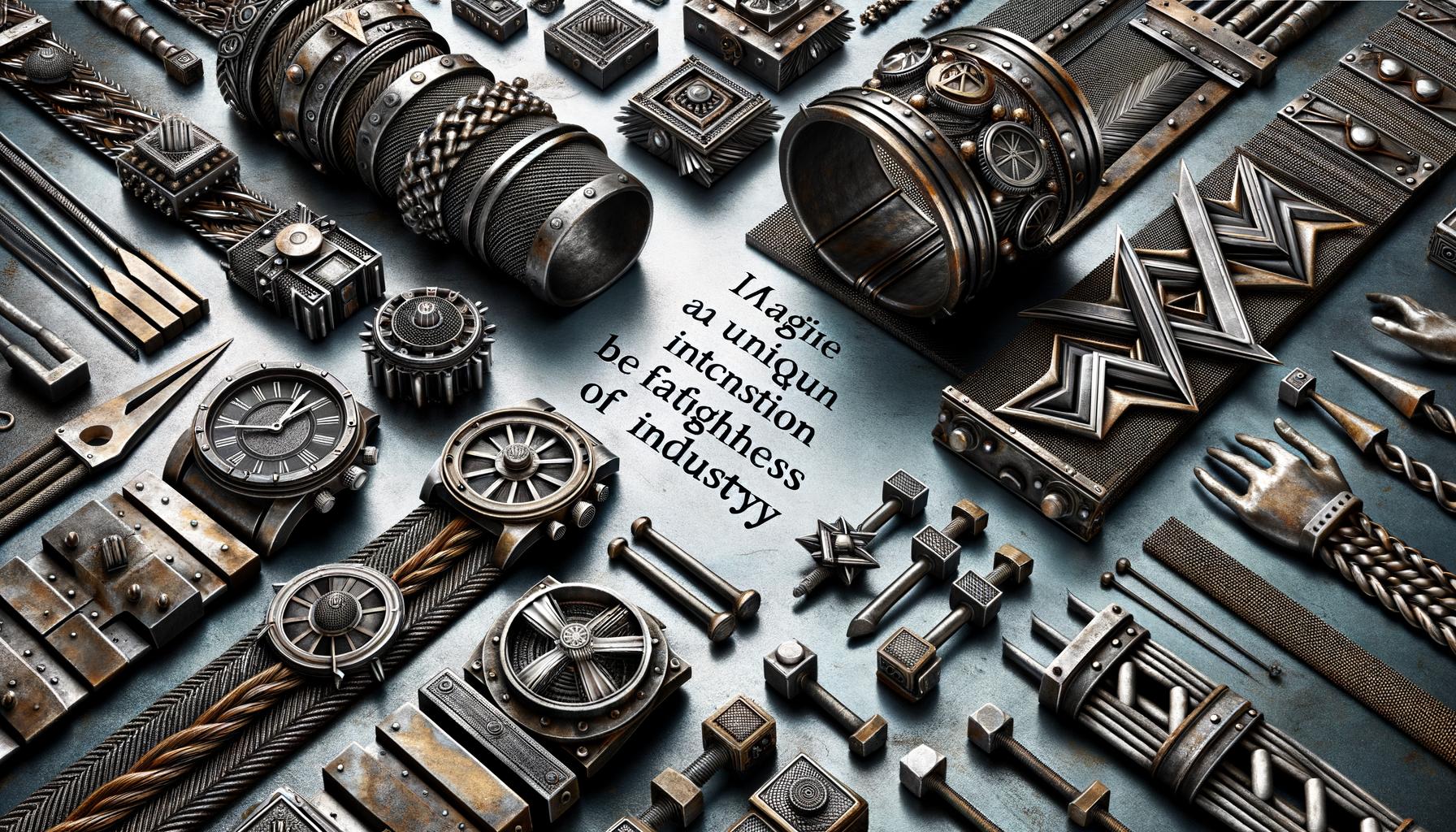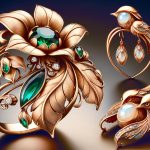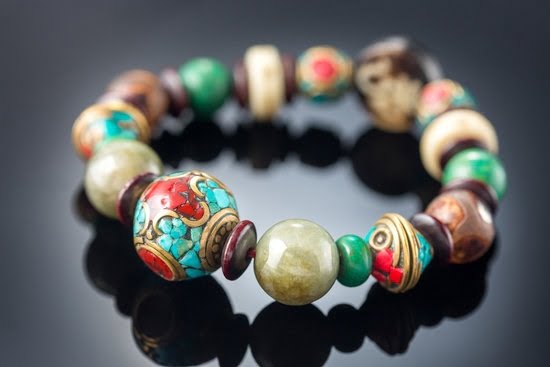Metal has always been an essential element in the world of fashion, but in recent years, a specific trend has emerged that goes beyond traditional jewelry design: industrial jewelry. Known for its innovative use of metals and edgy aesthetic, industrial jewelry represents the perfect intersection of metal and fashion.
It breaks away from conventional designs to offer pieces that are both bold and sophisticated, often incorporating elements one would associate more with machinery than jewelry. This unique blend has struck a chord within fashion circles, leading to its increasing popularity among designers and consumers alike.
What sets industrial jewelry apart is not just its material composition but also its inspired design techniques. Unlike traditional gold or gemstone pieces that are meticulously polished and refined, industrial jewelry embraces raw finishes, geometric shapes, and minimalist lines. Materials such as steel, titanium, and aluminum come into play, presenting durability alongside visual appeal. These aspects create an intriguing juxtaposition between the unrefined elements of industry and the meticulous craftsmanship associated with high-end fashion accessories.
The rise in popularity of industrial jewelry can be attributed to both its aesthetic versatility and durable nature. With its roots tracing back through various cultures and historical events that cherished metalwork in everyday objects, this style has evolved significantly over time.
In the contemporary fashion landscape, it stands out not just as a rebellion against traditional standards but also as an embodiment of innovative design where creativity knows no bounds. As industrial jewelry continues to gain traction on runways and in everyday wear alike, it is evident that this trend isn’t merely passing by-it’s here to redefine how we think about adornment entirely.
The Origins of Industrial Jewelry
The roots of industrial jewelry trace back to ancient civilizations where metal was not only a medium for functional tools but also for adornment. Early societies, such as the Egyptians and Mesopotamians, were pioneers in metalworking, employing techniques like hammering and casting to shape precious metals into intricate designs. These early forms of industrial jewelry demonstrated a transition from purely ornamental pieces to those imbued with power and symbolism.
During the medieval period, the use of metals expanded dramatically due to advances in craftsmanship and smelting technology. Blacksmiths began creating more than just weaponry; they ventured into producing sophisticated decorative objects.
Pieces like chainmail-inspired necklaces and bracelets emerged during this time, blending practicality with aesthetic appeal-an early exemplar of how industrial materials found their way into personal adornment. The Renaissance era further accelerated innovation in metalworking, offering new techniques like engraving that allowed for even more detailed and refined designs.
Fast forward to the 20th century, significant historical events such as the Industrial Revolution brought about a considerable shift in the jewelry-making landscape. With mass production becoming feasible, metals previously reserved for machinery found their way into fashion, bringing us closer to modern industrial jewelry: the intersection of metal and fashion we recognize today.
Pioneers like Alexander Calder began incorporating elements of industrial design into their work, using materials such as steel wire to create mobiles that doubled as art pieces and adornments. This period set the stage for contemporary designers who continue to push boundaries by merging raw industrial aesthetics with high fashion sensibilities.
Materials and Techniques
Metals That Define Industrial Jewelry
One of the defining elements of industrial jewelry: the intersection of metal and fashion lies in the choice of materials. Unlike traditional jewelry that predominantly uses precious metals like gold, silver, and platinum, industrial jewelry embraces a broader spectrum of metals, each contributing to its distinctive aesthetic and robustness. Stainless steel is a prevalent choice due to its durability and resistance to tarnish.
Its sleek appearance aligns well with the minimalist lines characteristic of industrial designs. Titanium is another favored metal, prized for its lightweight properties and strength; it’s often used in pieces intended for everyday wear owing to its hypoallergenic nature. Aluminum finds its place in this niche too, valued for being soft enough to craft intricate details yet sturdy enough for durable wear.
Mastering Metalwork: Techniques Used
Creating industrial jewelry involves an array of specialized techniques that underscore both craftsmanship and innovation. Welding is a fundamental technique where two or more metal pieces are fused together using high heat; this method allows for bold structural designs that emphasize geometric forms-a staple in industrial aesthetics.
Casting is another critical technique where molten metal is poured into a mold; it enables mass production while maintaining design complexity, perfect for making statement pieces like chunky rings or pendant necklaces. Engraving introduces personalization into industrial jewelry, allowing artisans to carve intricate patterns or text onto the metal surface, which adds a layer of bespoke charm amidst the raw edginess.
Focus on Durability
A significant appeal of industrial jewelry lies in its promise of longevity-a commitment rooted in both material choice and manufacturing techniques. The metals selected are inherently durable, capable of withstanding daily wear without losing their structural integrity or visual appeal. But beyond just picking robust materials like stainless steel or titanium, the methods employed also enhance durability.
For example, anodizing titanium not only increases its corrosion resistance but also allows for vibrant color finishes without compromising strength-a clever way to combine aesthetic variety with practicality. This blend of resilient materials and innovative techniques ensures that each piece not only stands out stylistically but also endures over time-underscoring the melding of form and function at the heart of industrial jewelry: the intersection of metal and fashion.
Design Aesthetics
The design elements that define industrial jewelry revolve around a unique blend of raw, unpolished aesthetics and refined, intricate designs. This style often emphasizes minimalist lines and geometric shapes that are both modern and timeless. Pieces may feature sharp angles, clean edges, and structural forms that evoke an industrial feel. These characteristics set industrial jewelry apart from traditional pieces which tend to have smoother curves and more organic details.
A distinct characteristic of industrial jewelry is the balance between raw finishes and meticulous craftsmanship. While some pieces boast an intentionally unpolished, rugged look with visible welds or tool marks, others have finely detailed engravings or precise etchings that add layers of complexity and sophistication.
This duality highlights the versatility of industrial jewelry: it can be simultaneously bold yet understated, making it suitable for various fashion contexts. It is this interplay between rawness and refinement that gives industrial jewelry its unique charm.
Examples of iconic industrial jewelry illustrate this juxtaposition splendidly. Jewelry designer Christopher Conte’s mechanical rings often utilize gears and metal components integrated into wearable art forms, reflecting both raw mechanical beauty and refined design execution.
Similarly, brands like Diesel incorporate chunky steel bracelets with sleek surfaces juxtaposed against rough textures to create compelling visual contrasts. These pieces serve as perfect illustrations of how industrial jewelry: the intersection of metal and fashion can capture attention while delivering a statement through simplicity paired with sophistication.
- Minimalist lines
- Geometric shapes
- Raw finishes
- Clean edges
- Visible welds or tool marks
- Bold yet understated designs
- Merging modernity with timelessness
- Sophisticated engravings or etchings
- Diverse styling possibilities for different contexts
Industrial Jewelry in High Fashion
The elevated status of industrial jewelry has not been overlooked by the high fashion arena, where its rugged allure meshes seamlessly with couture aesthetics. Renowned fashion designers have adopted industrial jewelry for its ability to juxtapose raw materials with refined craftsmanship, making statement pieces that captivate attention. From runway spectaculars to glossy magazine spreads, industrial jewelry: the intersection of metal and fashion creates a bridge between street style and luxury.
Notable fashion designers like Alexander McQueen and Rick Owens have masterfully incorporated industrial elements into their collections. McQueen’s darkly romantic themes often feature bold metallic chokers and cuffs that merge toughness with elegance. Similarly, Owens’ futuristic designs benefit from the inclusion of angular, metal accessories that emphasize the stark minimalism central to his brand ethos. This adoption by top-tier designers underscores how versatile and impactful industrial jewelry can be.
Luxury brands such as Balenciaga and Gucci have also embraced this trend, incorporating pieces that redefine traditional notions of opulence. Balenciaga’s catwalks showcase oversized earrings crafted from stainless steel, while Gucci’s eclectic collections often mix delicate gemstones with robust metallic chains. The showstopper effect of these pieces is undeniable:
- Balenciaga’s modernist steel earrings draw immediate focus.
- Gucci melds vintage vibes with contemporary design using mixed materials.
Furthermore, these industrial jewelry pieces frequently appear in elite fashion editorials where they enhance narratives centered on power, rebellion, and innovation. Leading publications like Vogue and Harper’s Bazaar curate photo shoots featuring models adorned in metallic arm cuffs or layered chain necklaces alongside haute couture garments. The fusion of metalwork detail complements the intricate fabric designs, solidifying industrial jewelry as a staple in high-fashion storytelling.
DIY and Indie Makers
The rise of industrial jewelry has found robust support in the DIY culture and among indie makers who are passionate about the intersection of metal and fashion. Small-scale designers and hobbyists are redefining what it means to create unique, personalized pieces that echo industrial aesthetics while maintaining individual flair. This grassroots involvement democratizes fashion, making it possible for anyone with a creative spark and some basic tools to delve into the world of industrial jewelry.
One key aspect of this movement is the accessibility of materials. Unlike precious metals like gold or platinum, industrial jewelry often employs more readily available metals such as stainless steel, titanium, or even repurposed materials like old screws and bolts. This not only makes crafting these pieces more affordable but also adds an element of sustainability. By recycling and reimagining discarded metal objects, indie makers contribute to a form of eco-conscious fashion that resonates with today’s consumers.
For those interested in dabbling in this craft, starting kits are widely available online, offering all the essential tools needed: soldering irons, engraving pens, wire cutters, and various types of metals. To blend raw and refined aesthetics successfully requires a balance between technique and creativity.
Tutorials on platforms like YouTube or specialized DIY websites provide step-by-step guidance on welding techniques or how to achieve specific finishes such as matte or polished looks. As more people turn toward handcrafted options over mass-produced items, indie makers stand at the forefront of this thriving subculture within the broader landscape of industrial jewelry.
Styling Industrial Jewelry
When it comes to styling industrial jewelry, understanding the versatility and statement-making potential of these pieces is key. One of the most remarkable aspects of industrial jewelry: the intersection of metal and fashion is its ability to bridge casual and formal styles seamlessly. For everyday wear, consider pairing a chunky steel bracelet with minimalist clothing such as a plain white tee and jeans. This approach allows the boldness of the jewelry to stand out without overwhelming your ensemble.
For more formal occasions, industrial jewelry can add an unexpected edge to elegant outfits. A sleek titanium pendant or geometric rings can complement a sophisticated black dress or tailored suit, adding a touch of modernity while maintaining class. It’s essential to balance the raw aesthetics typical of industrial pieces with refined clothing items to create an eye-catching contrast that’s both stylish and chic.
Drawing inspiration from celebrities and influencers can also be beneficial when styling industrial jewelry. Notable personalities like Rihanna and Gigi Hadid have been spotted sporting oversized metallic pieces that make strong style statements. By keeping other accessories minimal, they allow their industrial jewelry to shine as the focal point of their look. Mixing metals-like combining silver earrings with gold bracelets-can further elevate your fashion game, making you stand out in any situation.
| Styling Tip | Details |
|---|---|
| Everyday Wear | Pair chunky steel bracelets with minimalist clothing like a tee and jeans. |
| Formal Occasions | Add sleek titanium pendants or geometric rings to sophisticated dresses or suits for a modern touch. |
| Celebrity Inspiration | Look at how personalities like Rihanna utilize oversized metallic pieces as focal points. |
The Environmental Impact and Ethical Considerations
Industrial jewelry, comprising elements like steel, titanium, and aluminum, offers unique possibilities for sustainable fashion due to its inherent durability and potential for recycling. Many designers in the realm of industrial jewelry: the intersection of metal and fashion, are turning towards recycled materials to create their bold pieces.
The use of repurposed metals reduces waste and lessens the need for mining, which is notorious for its environmental damage. For instance, brands like Alkemie Jewelry focus on crafting their pieces from 100% reclaimed metals, showcasing that sustainability can go hand-in-hand with high fashion.
Ethical considerations also play a crucial role in industrial jewelry making. The sourcing of metals can have significant social and environmental implications. Ethical brands are committed to ensuring that their materials are obtained without exploiting labor or harming local ecosystems. For example, they might source their materials from suppliers who adhere to fair labor practices and ecological standards. Plus, some designers collaborate with certified fair-trade organizations to ensure that the entire supply chain upholds ethical standards.
Furthermore, consumer awareness around these issues is growing, pushing more brands toward transparency in their production processes. Customers now frequently demand proof that their purchases do not contribute to harmful practices. This shift encourages companies to adopt greener and more ethical methods of production-a trend likely to influence mainstream fashion significantly in the coming years.
| Brand | Sustainability Focus |
|---|---|
| Alkemie Jewelry | 100% reclaimed metals |
| Fair-Trade Organizations | Ethical sourcing of materials |
The Future of Industrial Jewelry
As the fashion world continues to embrace the edgy allure of industrial jewelry: the intersection of metal and fashion, predictions for its future are already stirring excitement among designers and enthusiasts alike. One anticipated trend is the integration of advanced materials, such as smart metals that can change shape or color in response to environmental stimuli. These innovations will likely propel industrial jewelry beyond mere aesthetic appeal, adding layers of functionality and interactivity that feel futuristic yet personal.
Equally intriguing is the potential for 3D printing technology to revolutionize how industrial jewelry is designed and produced. With advancements in precision and material diversity, 3D printing allows for unparalleled creativity and customization. Independent designers and major fashion houses may begin offering bespoke pieces that highlight personalized designs while maintaining the rugged charm inherent to the industrial aesthetic. This technology not only broadens creative horizons but also makes high-quality, unique pieces more accessible to a wide range of consumers.
Another significant shift could be a heightened focus on sustainability. As eco-consciousness grows within all sectors, including fashion, consumers are demanding products that are both stylish and responsible.
This might result in increased use of recycled metals-sourced from electronic waste or scrap materials-to create stunning pieces with minimal environmental impact. Brands dedicated to ethical practices will continue setting industry standards by incorporating fair labor policies and transparent sourcing methods to ensure an environmentally friendly footprint without compromising on design excellence.
Conclusion
In conclusion, industrial jewelry has carved a unique and influential niche within the fashion world, blending the raw power of metal with the creativity of design. The journey from its origins, embodying various cultural influences and historical events, to becoming a staple on high-fashion runways showcases the adaptability and timeless appeal of this style. Industrial jewelry’s ability to merge durability with aesthetics has made it a favorite among designers and fashion enthusiasts alike.
The integration of sustainable practices and ethical considerations further strengthens the position of industrial jewelry: the intersection of metal and fashion is not merely about appearance but also about making responsible choices. As artisans continue to innovate with recycled materials and fair labor practices, they contribute to an eco-friendly future while retaining the edgy allure that defines industrial jewelry. This commitment to sustainability ensures that this style will remain relevant and respected in a rapidly evolving fashion landscape.
Looking ahead, advancements in technology and design promise exciting developments for industrial jewelry. New materials and fabrication techniques could push creative boundaries even further, making it possible for both high-end designers and indie makers to craft extraordinary pieces.
Whether you are drawn to minimalist designs or intricate creations, embracing industrial jewelry allows you to appreciate a bold fusion that stands as a testament to human ingenuity and artistic expression. Explore this striking aesthetic for yourself, and experience firsthand how metal can transcend its utilitarian roots to become an integral part of contemporary fashion.

Welcome to my jewelry blog! My name is Sarah and I am the owner of this blog.
I love making jewelry and sharing my creations with others.
So whether you’re someone who loves wearing jewelry yourself or simply enjoys learning about it, be sure to check out my blog for insightful posts on everything related to this exciting topic!





